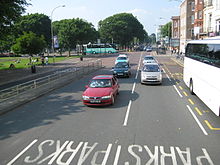- Old Steine
-
The Old Steine is a thoroughfare in central Brighton, East Sussex, and is the southern terminus of the A23. The southern end leads to Marine Parade, the Brighton seafront and the Palace Pier. The Old Steine is also the site of a number of City Centre bus stops for Brighton buses. The Royal Pavilion is located immediately to the north of the Old Steine.
History
The Old Steine was originally the centre of Brighthelmstone, and was an open green with a stream. The area was used by local fishermen to lay out and dry their nets. When Brighton started to become fashionable in the late 18th century, the area became the centre for visitors. Building around the area started in 1760, and railings started to appear around the green area in the 1770s, reducing its size. This continued throughout the 19th century. The eastern lawns of the Royal Pavilion were also originally part of the Old Steine.[1]
Dr. Richard Russell, whose 1750 paper on the health benefits of sea water helped to popularise Brighton, had a house built on the Old Steine in 1759; the site is now occupied by the Royal Albion Hotel.[2]
Maria Fitzherbert lived in Steine House on the west side of the Old Steine from 1804 until her death in 1837.[3]
Etymology
The word Steine comes from the Old English stoene, meaning "stony place". The name either came from the abundance of large stones in the area on which fishermen dried their nets, or from the presence of a sarsen stone circle in the vicinity of St Nicholas' Church.[4]
References
- ^ Roles, John (22 March 2006). "Old Steine - History notes". My Brighton and Hove. http://www.mybrightonandhove.org.uk/page_id__6086.aspx. Retrieved 2011-09-14.
- ^ Drury, Jennifer (27 August 2006). "Dr Richard Russell's house was in the Old Steine". My Brighton and Hove. http://www.mybrightonandhove.org.uk/page_id__7539.aspx. Retrieved 2011-09-14.
- ^ Drury, Jennifer (28 August 2006). "Maria Fitzherbert's house in the Old Steine". My Brighton and Hove. http://www.mybrightonandhove.org.uk/page_id__7540.aspx. Retrieved 2011-09-14.
- ^ "Old Steine. Notes and Queries: origins of the name?". My Brighton and Hove. 22 March 2006. http://www.mybrightonandhove.org.uk/page_id__6089.aspx. Retrieved 2011-09-14.
Coordinates: 50°49′14″N 0°08′15″W / 50.82056°N 0.1375°W
Buildings and structures in Brighton and Hove Heritage Conservation areas · Listed buildings: Grade I · Grade II* · Grade II: A–B · C–D · E–H · I–L · M · N–O · P–R · S · T–V · W–Z




Places of worship List of places of worship (see list for links to individual articles) · List of demolished places of worship
Houses, flats
and mansionsChartwell Court · Embassy Court · Fife House · French Convalescent Home · 75 Holland Road · Marlborough House · New England Quarter · Ovingdean Rectory · Patcham Place · Pelham Institute · Preston Manor · Stanmer House · Sussex Heights · Van Alen Building · Western Pavilion
Crescents,
squares and
terracesAdelaide Crescent · Bedford Square · Belgrave Place · Bloomsbury Place · Brunswick Town · Hanover Crescent · Kemp Town · Lansdowne Square · Marine Square · Montpelier Crescent · New Steine · Norfolk Square · Norfolk Terrace · Old Steine · Oriental Place · Palmeira Square · Park Crescent · Pelham Square · Powis Square · Regency Square · Roundhill Crescent · Royal Crescent · Russell Square · Vernon Terrace · Wykeham Terrace
Commercial
buildingsAmex House · Brighton Forum, 95 Ditchling Road · Churchill Square · 20–22 Marlborough Place · 9 Pool Valley
Institutional and
civic buildingsBHASVIC · Brighton General Hospital · Brighton Town Hall · Hove Town Hall · Jubilee Library · Ovingdean Hall School · Royal Alexandra Hospital · Royal Sussex County Hospital · University of Sussex · Varndean College
Hotels and inns Hotels: Bedford · Grand (1984 bombing) · Metropole · Old Ship · Royal Albion · Royal York · Inns and pubs: The Cricketers · Evening Star · Freemasons Tavern · Hangleton Manor Inn · King and Queen · Royal Pavilion Tavern
Entertainment
and leisureAstoria (former) · Brighton Centre · Brighton Dome and Pavilion Theatre · Brighton Hippodrome (former) · Brighton Marina · Brighton Wheel · Duke of York's Picture House · Falmer Stadium · King Alfred Centre · Royal Pavilion · Saltdean Lido · Theatre Royal · Withdean Stadium · Museums: Booth Museum · Brighton Fishing Museum · Brighton Museum and Art Gallery · Brighton Toy and Model Museum · British Engineerium · Hove Museum and Art Gallery
Piers Brighton Pier · The Royal Suspension Chain Pier (demolished) · West Pier
Windmills Miscellaneous Barford Court · Chattri · Clock Tower · 11 Dyke Road · Foredown Tower · i360 (proposed) · Pepper Pot · St Dunstan's · Sassoon Mausoleum · Steine House (YMCA)
Related topics Ammonite Order · Bungaroosh · Cemeteries and crematoria · Mathematical tiles · Regency architecture · Architects: Charles Busby · John Leopold Denman · Thomas Lainson · John Nash · Basil Spence · Amon Henry Wilds · Amon Wilds

This England road or road transport-related article is a stub. You can help Wikipedia by expanding it.




